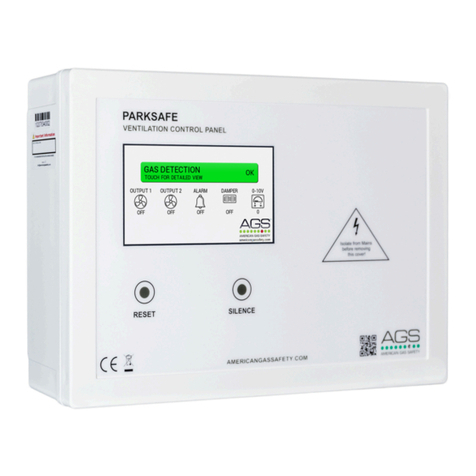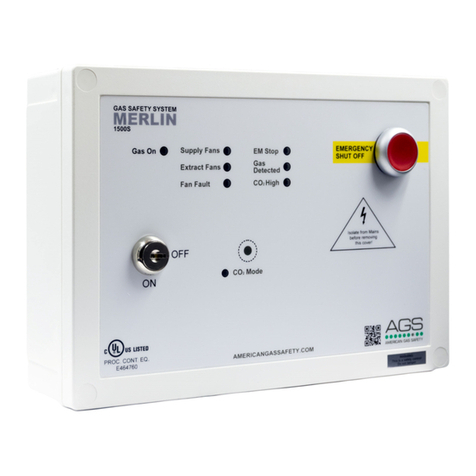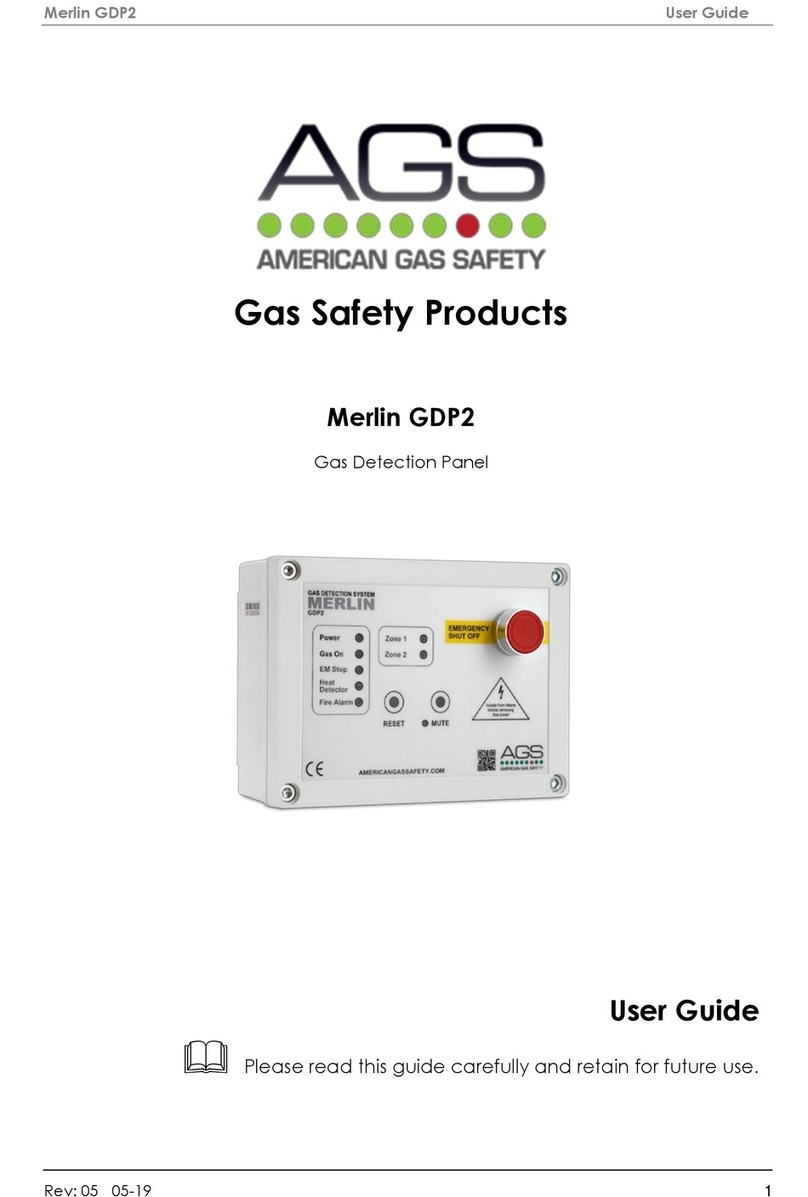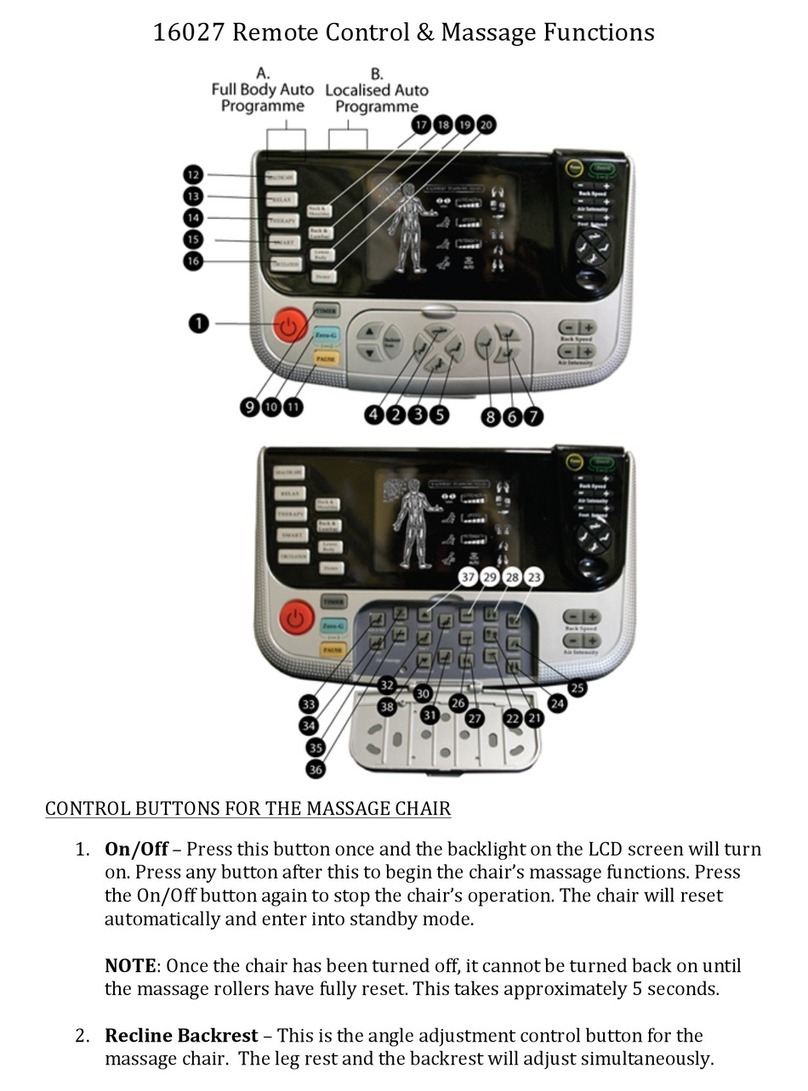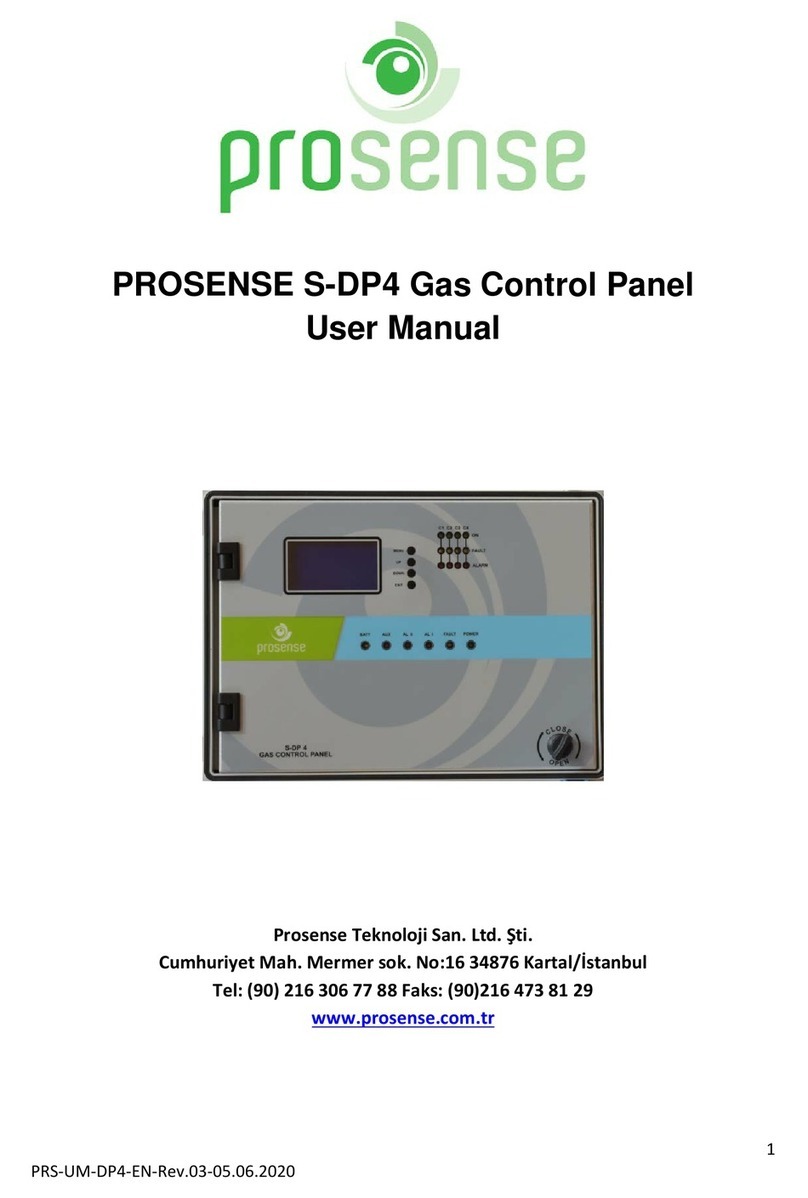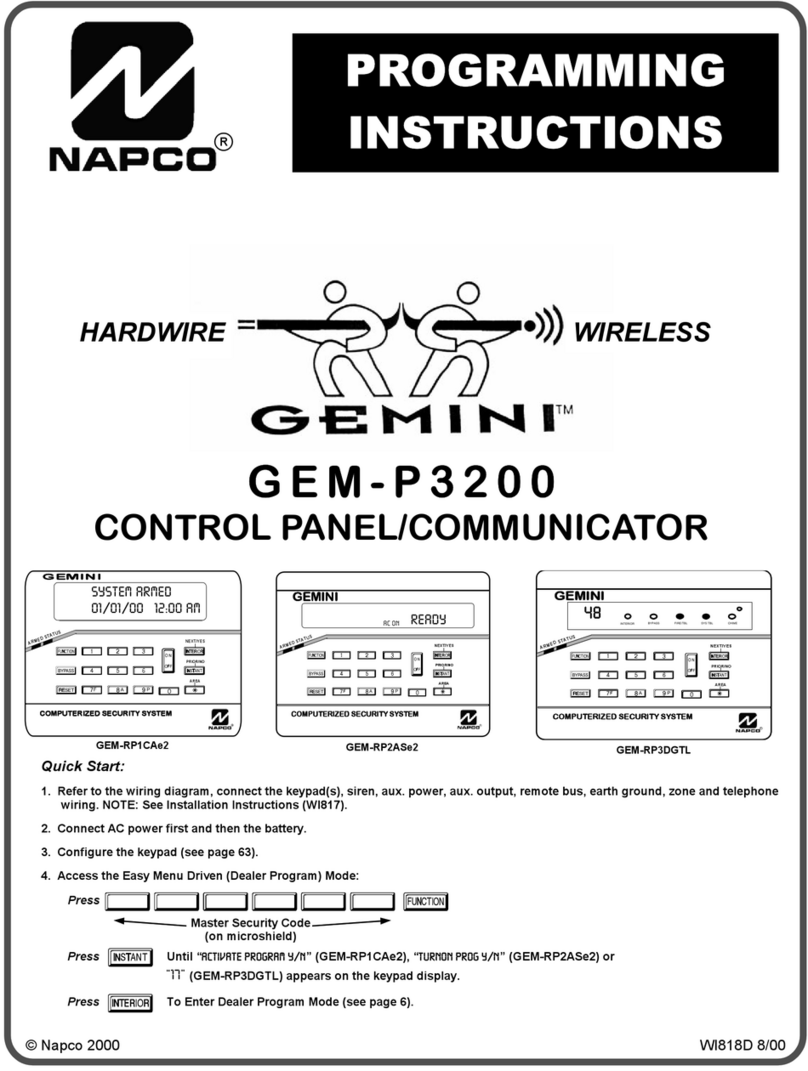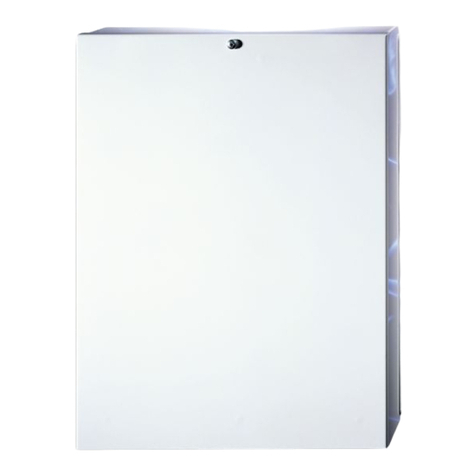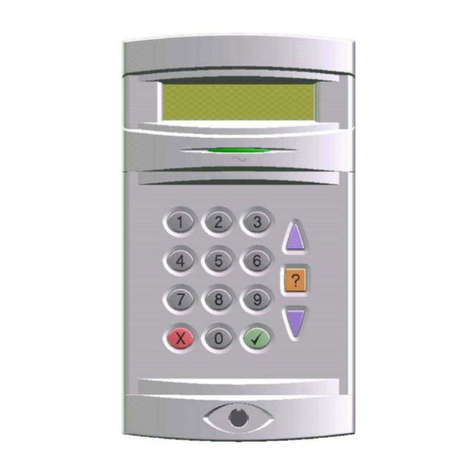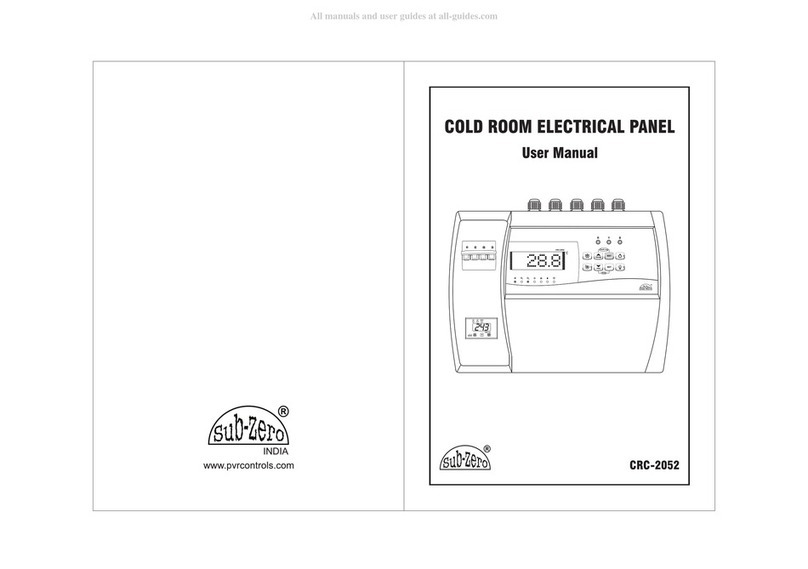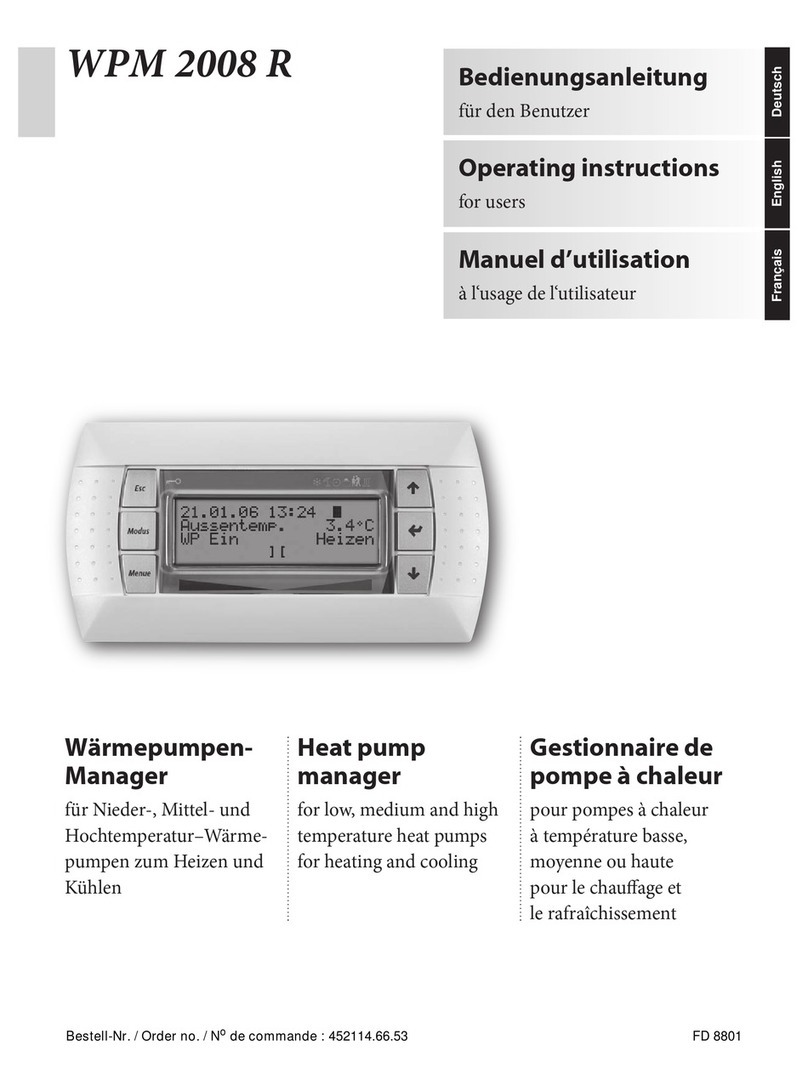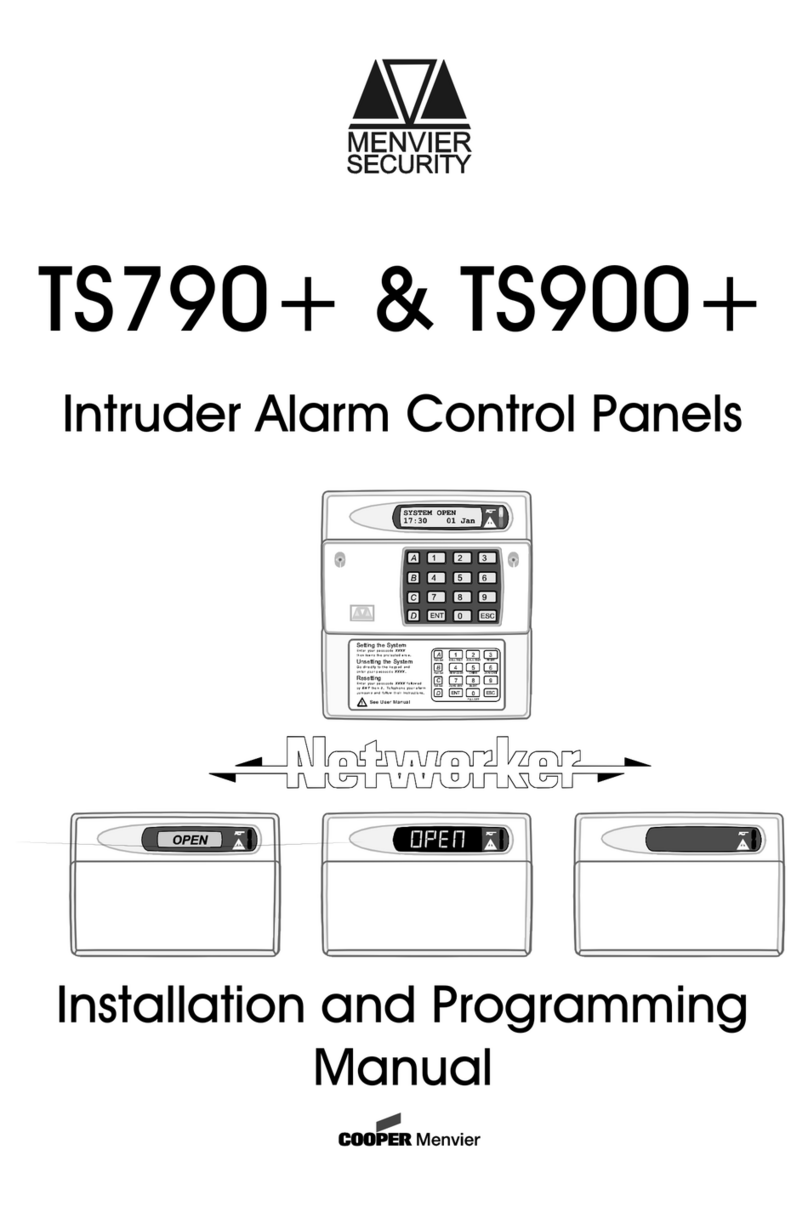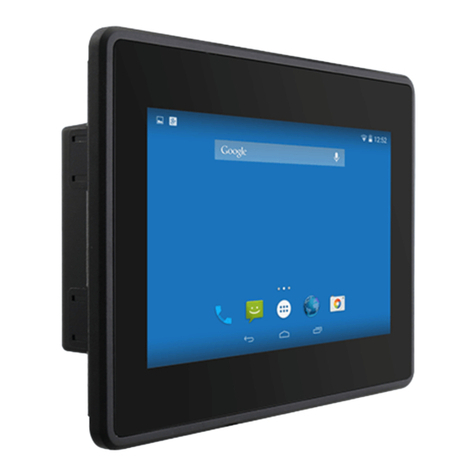AGS Parksafe Control Panel Owner's manual

Installation, Operation & Maintenance Parksafe Control Panel
Rev: 13 0721 1
Parksafe Ventilation Control Panel
Ventilation Control System
Installation, Operation & Maintenance
Please read this manual carefully and retain for future use.
The control panel designed to be paired with Parksafe Nitrogen Dioxide (NO2) and Carbon Monoxide (CO) gas detectors
for installation in car parking facilities and enclosed garages. The control panel will monitor up to 16 gas detectors per
cable run and automatically control ventilation systems according to gas levels and temperature.
The information contained within this manual should be referenced for typical installation and operation only.
For specific requirements that may deviate from the information in this manual –contact your supplier.

Installation, Operation & Maintenance Parksafe Control Panel
Rev: 13 0721 2
Content
Important Warning Statements ..................................................................3
Installation ...................................................................................................4
Typical Location and Positioning .........................................................................................4
Access & Mounting................................................................................................................5
Main Board Overview............................................................................................................5
Main Board Connections ......................................................................................................6
Wiring a Detector ...................................................................................................................7
Wiring a Detector Chain........................................................................................................7
Detector ID Switches.............................................................................................................8
120ohm Termination Resistance .........................................................................................8
Quick Circuit Test ..................................................................................................................8
Access Configuration Settings.............................................................................................8
Settings Menu ........................................................................................................................9
Menu Options Explained.......................................................................................................9
Factory Set Condition ...........................................................................................................9
Installation Tips.....................................................................................................................10
Trouble Shooting .................................................................................................................10
Operation...................................................................................................11
First Power Up......................................................................................................................11
Home Screen Overview......................................................................................................11
Temperature Status & Icon ................................................................................................11
Silence & Reset....................................................................................................................12
Accessing Gas Detection Information...............................................................................12
Detector Status ....................................................................................................................12
Gas Detector Alarm Set Points ..........................................................................................12
Modbus Communication Rescan.......................................................................................12
General Maintenance ................................................................................13
Cleaning ................................................................................................................................13
Manual Circuit Simulation Test ..........................................................................................13
Annual Service Message ....................................................................................................13
End of Operational Life (EOL) ............................................................................................13
Bump Test (Gas Response Check) ...................................................................................14
Specification..............................................................................................15

Installation, Operation & Maintenance Parksafe Control Panel
Rev: 13 0721 3
Important Warning Statements
Before any installation, use or maintenance read this manual carefully.
The information contained within this manual should be referenced for typical installation and operation only.
For site specific requirements that may deviate from the information in this guide –contact your supplier.
If this device is used in a manner not specified by the manufacturer, the safety and provided by this device may be impaired.
This device is designed for indoor operation only.
The expected lifetime of a NO2 gas sensor element is 2 years upon initial power up. The Parksafe control panel will display a
message to indicate this time and detectors should immediately be replaced.
The expected lifetime of a CO gas sensor element is 5 years upon initial power up. The Parksafe control panel will display a
message to indicate this time and detectors should immediately be replaced.
It is recommended that this device be commissioned upon installation and serviced annually.
Do not apply lighter gas or other aerosols to the device –this will cause extreme damage.
High concentrations of alcohol / ethanol found in many products may damage, deteriorate or affect the gas sensing elements –
Avoid exposure near your device.
This equipment is designed to detect carbon monoxide and nitrogen dioxide from any source of combustion.
It is NOT designed to detect smoke, fire or other gases and should NOT be used as such.
DO NOT remove the gas sensing module when the system is powered up.
This device provides early warning of the presence of nitrogen dioxide or carbon monoxide, usually before a healthy adult would
experience symptoms. This early warning is possible provided your alarm is located, installed and maintained as described in
this guide.
This device requires a continual supply of electrical power –it will not work without power.
This device should not be used to substitute proper installation, use and / or maintenance of fuel burning appliances including
appropriate ventilation and exhaust systems.
This device does not prevent nitrogen dioxide or carbon monoxide from occurring or accumulating.
Actuation of your alarm indicates the presence of dangerous levels of NO2or CO.
Seek fresh air supply and contact your local gas emergency service should you suspect a gas leak.
This device may not fully safeguard individuals with specific medical conditions.
If in doubt, consult a doctor / physician.
Your product should reach you in perfect condition, if you suspect it is damaged, contact your supplier.
Manufacturer’s Warranty
Coverage: The manufacturer warrants to the original consumer purchaser, that this product will be free of defects in material and
workmanship for a period of three (3) years from date of purchase. The manufacturer’s liability hereunder is limited to replacement of
the product with repaired product at the discretion of the manufacture. This warranty is void if the product has been damaged by
accident, unreasonable use, neglect, tampering or other causes not arising from defects in material or workmanship.
This warranty extends to the original consumer purchaser of the product only. Disclaimers: Any implied warranties arising out of this
sale, including but not limited to the implied warranties of description, merchantability and intended operational purpose, are limited in
duration to the above warranty period. In no event shall the manufacturer be liable for loss of use of this product or for any indirect,
special, incidental or consequential damages, or costs, or expenses incurred by the consumer or any other user of this product, whether
due to a breach of contract, negligence, strict liability in tort or otherwise. The manufacturer shall have no liability for any personal injury,
property damage or any special, incidental, contingent or consequential damage of any kind resulting from gas leakage, fire or
explosion. This warranty does not affect your statutory rights. Performance: During the above warranty period, your product will be
replaced with a comparable product if the defective product is returned together with proof of purchase date. The replacement product
will be in warranty for the remainder of the original warranty period or for six months –whichever is the greatest.
Information on waste disposal for consumers of electrical & electronic equipment.
When this product has reached the end of its life it must be treated as Waste Electrical & Electronics Equipment (WEEE). Any
WEEE marked products must not be mixed with general household waste, but kept separate for the treatment, recovery and
recycling of the materials used. Please contact your supplier or local authority for details of recycling schemes in your area.
At the end of their working life, electrochemical sensors for parksafe detectors should be disposed of in an environmentally safe
manner.Alternatively all detectors can be securely packaged and returned to AGS clearly marked for disposal.
Electrochemical sensors should not be incinerated as this may cause the cell to emit toxic fumes.

Installation, Operation & Maintenance Parksafe Control Panel
Rev: 13 0721 4
Installation
Typical Location and Positioning
The Parksafe control panel is designed for installation into car parking facilities and enclosed garages. It is designed to be
paired with AGS Parksafe Gas Detectors (Nitrogen Dioxide and Carbon Monoxide) that will be linked via MODBUS back
to the control panel and monitor the connected detectors in numbers up to 16 (per control panel) and automatically
control ventilation systems according to gas levels and an optional temperature level.
The Parksafe will make or break a dry contact internally on terminals: OUTPUT 1 and a second contact on OUTPUT 2.
This is to have a live feed to the ventilation system wired through the contact so that the Parksafe can activate ventilation/
fans, this can either be via a direct live feed or via a run signal. There is another output relay that will activate after
OUTPUT 2 has been activated for an optional extended period of time. This can be used for a link to the BMS or other
external indication device.
The Parksafe also has a 0-10VDC output to allow the panel to drive VSD’s based on gas level outputs. The Parksafe
control panel is designed to be located in an office or other suitable area within a carpark not accessible to the public.
Please refer to your detector manual for important information regarding coverage, location and positioning including areas
and conditions to avoid!
Place the control panel in accordance with regulations ensuring optimum access and monitoring.
The control panel should be located outside of the hazardous area that it is monitoring. Easy accessibility is required both
for status observation and alarm purposes.
The quality of the data signals will vary depending on cable size, number of detectors, the quality and length of the cable run.
Where connections may exceed 500 yards from one control panel. Contact your supplier should issues occur!
The use of sound strobes are highly recommended!

Installation, Operation & Maintenance Parksafe Control Panel
Rev: 13 0721 5
Access & Mounting
Unpack all the parts!
Designed for surface mounting, it must be installed by a licensed,
insured contractor.
1. Carefully remove the front cover from the unit by unscrewing the
four bolts located at each corner. To do this –use the socket
wrench provided.
2. Mark the four screw holes located on the back of the enclosure to
the wall. Ensure the wall surface is flat to prevent base distortion.
3. After executing the mounting and the connections –replace the
front cover and insert the security caps over the four bolts.
Main Board Overview
Be careful when creating access for cables –Damage to circuit boards will void any warranty!
Any damage attempting to remove the circuit board parts may void any warranty!
Detectors must be earthed/grounded for electrical safety and to limit the effects of EMC or R/F interference!
For MODBUS communications, a shielded cable is used!
Do not remove the Gas Sensor Module when the system is powered!

Installation, Operation & Maintenance Parksafe Control Panel
Rev: 13 0721 6
Main Board Connections
1. POWER/ LINE IN.
110-120Vac mains power should be supplied to the [POWER/LINE IN] connector using a 3 core cable and fused at
3A. When mains power supplied to the panel - a red LED will illuminate located on the front cover.
2. OUTPUT 1 RELAY.
This relay output switches when any external gas detectors reach ‘pre-alarm’ status and the [0-10V OUTPUT] will
send 5V to ventilation systems.
OUTPUT 2 RELAY.
This relay output switches when any external gas detectors reach ‘alarm delay’ status and the [0-10V OUTPUT] will
send 10V to ventilation systems.
ALARM RELAY.
This relay output switches when any external gas detectors reach ‘alarm delay’ status for longer than the selectable
5 - 25 minutes time following the [OUTPUT 2] relay.
DAMPER RELAY.
This relay output can switch together with either OUTPUT 1, OUTPUT 2 or ALARM relays - selectable in the settings
menu.
3. DETECTOR CHAIN.
24vdc power and Modbus data is wired to Parksafe gas detectors [DETECTOR CHAIN] - [+ / - / D+ / D-].
Up to 16 detectors can be connected, chained in parallel up to approx. 500 yards from the panel depending on chain
configuration, wire type for power and condition. Connect detectors in a parallel (daisy chain) method.
Any other way may cause communication issues or damage to the overall system.
For MODBUS communications, a shielded and twisted pair cable is used. The shielding can be of 2 types: braided
[mesh of thin conducting wires] or foil (consisting of a thin sheet of metal covering the twisted wires).
If you are encountering noise or irregular problems with a Modbus link, the problem is likely related to grounding,
incorrect shielding or wiring mains power next to Modbus wiring.
For more information, refer to your Parksafe detector manual.
4. SOUNDER/ STROBE.
This relay output (24VDC) is for an external sounder alarms/ strobe lighting to activate on alarm.
5. 24VDC.
This is a permanent 24Vdc power output for external auxiliary devices. Max output: 200mA.
6. 0-10V OUTPUT.
This output can drive ventilation systems. Under normal operating conditions, this output can send either 0 or 2V –
selectable in the settings menu. The [0-10V OUTPUT] will send 5V when [OUTPUT 1] relay is activated and 10V
when [OUTPUT 2] relay is activated.

Installation, Operation & Maintenance Parksafe Control Panel
Rev: 13 0721 7
Wiring a Detector
Power and Modbus data are wired between detectors with the first connected
to a control panel DETECTOR CHAIN terminal. If using a shielded wire
(recommended) then connect the shield to [-] power terminals.
For MODBUS communications, a shielded cable is used.
The shielding can be of 2 types: braided [mesh of thin conducting wires] or
foil (consisting of a thin sheet of metal covering the twisted wires).
One example of such cable is BELDEN 3082A.
If you are encountering noise or irregular problems with a Modbus link, the
problem is likely related to grounding, incorrect shielding or wiring mains power next to Modbus wiring.
To ground the data cable, the shield should be connected to [-] of the chain terminals.
Reversing the [D+] and [D-] connections of any device can lead to the whole system to stop working owing to reverse
polarity found on the terminals.
The detector must be earthed/grounded for electrical safety and limit the effects of R/F & EMC interference!
Ensure the 120-ohm termination resistance switch is on at each end of a cable run!
Wiring a Detector Chain
Up to 16 Parksafe detectors can be connected, chained in a parallel ‘daisy chain’ method up to approx. 500 yards from
the panel depending on chain configuration, wire type for power and condition. Any other way may cause issues or
damage to the overall system. It is recommended that the cable of same color should be used to connect all [D+]
terminals together and similarly cable of same color to be used to connect all [D-] terminals together.
Split chain example from a Parksafe Control panel. Single chain example from the Parksafe Control Panel.

Installation, Operation & Maintenance Parksafe Control Panel
Rev: 13 0721 8
Detector ID Switches
When wiring multiple detectors it is important to identify each detector installed for the
control panel to receive and display accurate data corresponding with the correct
device.
The ID configuration diagram is printed onto detector boards for quick
reference as shown opposite. All detectors are factory set to ID1.
We recommend a plan, map and/or marking the detector enclosures detailing ID and location!
ID Switches must be configured for each detector connected to receive and display accurate data!
120ohm Termination Resistance
Signal communication issues may occur where the bus length is too long, high baud
rates are used or signal reflections are occurring. To avoid this, terminating at each end
of a chain may help the quality of the data signal by turning on the 120-ohm terminal
resistor switch.
If a split chain is used, terminate the last detector in each chain.
If a single chain is used, terminate the first device (Panel) and last device (Detector).
Split chain Single chain
Quick Circuit Test
When the test button on the detector board is pressed and held –the detector will simulate an open circuit to ensure all
configured systems, outputs, alarms, indications and other external devices operate as intended in response to gas.
When the test button is released –the test sequence will terminate and return to normal operation.
Access Configuration Settings
On the front display circuit board you’ll find a SETTINGS switch – when switched on, the screen will display the settings
menu –you can now configure your Parksafe system.
When changes have been made –turn the settings switch off and the panel will restart!

Installation, Operation & Maintenance Parksafe Control Panel
Rev: 13 0721 9
Settings Menu
The Parksafe panel has a touch screen which allows the engineer/user to configure the system.
Adjust the screen brightness. Change/select option.
(Press or slide the cursor up and down) (Press the blue option box or press and hold)
Menu Options Explained
FUNCTION
OPTION
Explanation
Auto Start
- ON
- OFF
In the event of a power loss - the Parksafe panel will automatically restart when
power is restored, or not.
0-10V Minimum Value
- 0 or 2V
0-10V terminal output under normal / safe conditions.
Alarm Time Delay
- 5 to 25
Time (minutes) for alarm relay to switch when detectors reach alarm status.
(Following second relay Output 2). 5, 10, 15, 20 or 25minutes,
Damper Follows
- Output 1
- Output 2
- Alarm
The Damper relay output can switch together with either [OUTPUT 1], [OUTPUT 2]
or the [ALARM] relays.
Temperature Alarm
- >68 to 86°F
- Off
All Relays except Alarm will switch when the defined temperature (F°) is exceeded.
Select Off to disable function. Relays switch back when defined temperature
reaches 4°F below selected threshold.
Factory Set Condition
Auto Start
- ON
Panel will restart following a power cut/loss.
0-10V Minimum Value
- 0V
No voltage output under normal condition status.
Alarm Time Delay
- 5
Following Output 2 relay switching, the Alarm relay will activate after five (5)
minutes.
Damper Follows
- Output 1
Damper relay switches with [Output 1] relay.
Temperature Alarm
- Off
Temperature alarm disabled.

Installation, Operation & Maintenance Parksafe Control Panel
Rev: 13 0721 10
Installation Tips
CONNECTION
The best way to connect devices in a MODBUS RTU is a ‘DAISY CHAIN’method.
MAXIMUM DISTANCE
You may encounter problems when powering gas sensors beyond 500 yards from one control panel, in this instance,
contact your supplier.
TERMINAL RESISTANCE
Signal communication issues may occur. To avoid this, terminating at each end of a chain may help the quality of the data
signal by turning on the 120ohm terminal resistor switches.
GROUNDING
If you are encountering noise or irregular or abnormal problems with a Modbus link, the problem is likely related to
grounding, incorrect shielding or wiring main power next to Modbus wiring. To ground the data cable, the shield should
be connected to [-] of the chain terminals including the control panel.
CABLES TO USE
A shielded and twisted pair cable is used. The shielding can be of 2 types: braided [like a mesh of thin conducting wires]
or like a foil [consisting of a thin sheet of metal covering the twisted wires].
PROTECTION
High concentrations of alcohol found in many products may damage, deteriorate or affect the gas sensing elements of
Detectors –such as; wine; deodorants; stain removers; thinners etc.
IDENTIFICATION
Remember to individually ID each connected detector by configuring the ID switches on the circuit board. Make a plan,
map and/or note of the location of all connected detectors for tracing and locality purposes.
Trouble Shooting
ISSUE
POSSIBLE CAUSE
CHECK
Panel searches for detectors at start
up but doesn’t establish connection
Broken data cable in the chain.
Gas sensing module not properly connected
in one or more detectors.
Cables connected are secure and in the
correct terminals.
Ensure the gas-sensing module installed has
not come loose.
Press the rescan button on the panel.

Installation, Operation & Maintenance Parksafe Control Panel
Rev: 13 0721 11
Operation
First Power Up
Upon connecting mains power, the Parksafe control panel will load for approximately 60 seconds. During this time the
screen will display an ‘initialising’ screen. The panel will then begin establishing signals with any Parksafe gas detectors.
Home Screen Overview
System OK.
Under normal/safe conditions.
System in ‘Pre-Alarm’ condition.
When detected gas reach pre-alarm levels.
OUTPUT 1 relay: activated.
0-10V output: 5V
Other external devices may activate if configured to do so.
System in ‘Alarm Delay’ condition.
When detected gas reach dangerous alarm levels.
OUTPUT 2 relay: activated.
0-10V Output: 10V
Other external devices may activate if configured to do so.
System in Alarm condition.
When gas levels remain dangerous beyond the alarm delay.
ALARM relay: activated.
Gas detector ID appears on screen.
The internal buzzer will sound to alert the user.
The detector ID of the first signal received will be displayed on screen only.
All outputs will remain active until the system is reset.
Temperature Status & Icon
This feature is factory set to off.
If enabled and the temperature levels exceed the selectable threshold, the
temperature icon appears and the system switches both OUTPUT 1 & 2, the
Damper relay and the 0-10V output at 10Volts.
All outputs will remain active until the temperature (monitored by Parksafe Detectors) drops below 4°F of the specified
threshold –adjustable in the configuration settings menu.

Installation, Operation & Maintenance Parksafe Control Panel
Rev: 13 0721 12
Silence & Reset
To silence the internal buzzer –press the Silence button on the front panel.
This will also silence any external audio sounders connected to the panel.
If the system reaches alarm condition –the panel will need to be reset when the gas levels detected return
to a safe level.
Check the detector status pages to identify where gas has been detected and if levels have returned to a
safe condition before resetting the system.
Accessing Gas Detection Information
To access detector status screens press the ‘Gas Detection’section on screen any time.
Switch between pages by touching the relevant page button.
Each page can display up to 4 detectors as follows:
a. The ID configured via switches on each detector board.
b. The unique serial number for that detector.
c. The target gas that detector is monitoring.
d. The status of gas levels, errors and messages.
e. The concentration value of gas detected.
To return to the main screen, press the home button on screen.
Detector Status
GOOD
oGas levels are safe / No error conditions.
PRE ALARM
oGas detected has reached pre-alarm levels.
ALARM
oGas detected has reached alarm levels.
FAULT
oGas sensor module has an issue (Removed or not properly installed) or service required.
END OF LIFE
oThe gas-sensing element has reached the end of its expected lifecycle.
SERVICE
oGas sensing element requires periodic bump test/service.
-- X --
oDetector signal lost, not installed or not configured correctly.
Gas Detector Alarm Set Points
Gas Detector
Pre-Alarm
Alarm State
▲Rising alarm ▼Falling alarm PPM (Parts per Million)
Carbon Monoxide (CO)
▲25ppm
▲ 100ppm
Nitrogen Dioxide (NO2)
▲0.7ppm
▲2.0ppm
Modbus Communication Rescan
At any time, the user can rescan and refresh the Modbus communication data if there is a bad connection
in the chain by pressing the icon on screen. When pressed the system will search for all signals connected
to the panel i.e. gas detectors without the need to reset the system.

Installation, Operation & Maintenance Parksafe Control Panel
Rev: 13 0721 13
General Maintenance
Cleaning
Keep your gas detector and panel in good working order - follow these basic principles;
Remove any dust/debris from the outer enclosure regularly using a slightly damp cloth.
Never use detergents or solvents to clean your device.
Never spray air fresheners, hair spray, paint or other aerosols near the device.
Never paint the device. Paint will seal vents and interfere with the device.
Concentrations of alcohol found in many products may damage, deteriorate or affect the gas sensing elements
such as; wine; deodorants; stain removers and thinners. Other gases and substances to avoid are; corrosives (i.e.
chlorine & hydrogen chloride); alkali metals; basic or acidic compounds; silicones; tetraethyl lead; halogens and
halogenated compounds!
Manual Circuit Simulation Test
When the test button on the circuit board is pressed and held the detector will simulate an open circuit to ensure
configured systems, outputs, alarms, indications and other external devices operate as intended in response to gas.
When the test button is released –the test sequence will terminate and return to normal operation.
Access to the interior of the detector, when carrying out any work, must be conducted by a competent person!
This test does not check the gas sensing element itself!
Annual Service Message
It is recommended that the system be serviced at least annually from the date of installation for optimum performance
and protection due to sensitivity drifts. A service message will appear on the Parksafe control panel after one year of
detector operation. The detector will still operate during this time but contact your supplier immediately.
The annual service message clock will begin after five (5) hours of continuous power irrespective of whether the system is then
used intermittently. To reset it, the unmarked header on the detector board will need to be shorted out.
End of Operational Life (EOL)
The typical life of a gas detector depends on its application and intended target gas, in addition, the operational life can
be prolonged if the system and equipment is installed and maintained in accordance the instructions stated within this
manual. A message on the Parksafe control panel will indicate that a detector has reached its expected operational
lifecycle. This means the gas-sensing module needs replacing and the affected Parksafe detector, ‘Fault’ LED will remain
illuminated.
The EOL is approximate from the first five (5) hours of continuous power!
The EOL will depend on the type of gas your detector is targeting and may vary depending on its application and environmental
conditions such as the frequency of exposure to the target gas, poisons or inhibitors!

Installation, Operation & Maintenance Parksafe Control Panel
Rev: 13 0721 14
Bump Test (Gas Response Check)
Gas response checks are often referred to as a ‘bump test’. Bump tests are important to make sure a device is able to
detect a release of gas as early as possible. The aim of the bump test is to make sure a detector is working at its optimum
by briefly exposing the unit to a known concentration of the target gas that usually exceeds the highest alarm point. If the
detector goes into alarm and all signals/outputs activate, then the system is working safely. If the system fails to operate
as intended in an alarm state, the gas detector must not be used until a full inspection and service has been conducted.
A detector may visually appear in good working order, but its sensitivity can be inhibited by external factors. Dust,
humidity, temperature fluctuations, cleaning products, contaminants or sensor drift (ageing) can cause a decline in
sensitivity and eventual failure. Regular bump tests are important to make sure the detector is able to detect a release of
gas as early as possible and usually takes seconds (gas type dependant i.e. CO sensors will take over a minute). It is
often completed alongside a scheduled fire alarm test; however, the frequency should be determined following an
appropriate risk assessment by the end user. Remember, bump testing does not remove the need to have gas detectors
inspected, calibrated and serviced periodically by a competent person.
Contact your S&S Northern representative for details of suitable bump testing kits and gases. Kits usually consist of a
certified gas cylinder; flow control regulator, tube pipe and applicator cone. We recommend only using S&S Northern
calibration gas kits to ensure correct flow rates meet S&S Northern technical requirements. A bump testing gas is usually
a concentration mix that exceeds the highest alarm set-point.
See below for recommended gas concentrations for bump testing your detector.
Detector Type
Bump Test Gas
Response Time t90
CO - Carbon Monoxide
300ppm (balance in air).
<60s
NO2 –Nitrogen Dioxide
5.0ppm (balance in air)
<60s
All certified test gases supplied by S&S Northern are classified as non-flammable and non-toxic, however, they do
contain gas under pressure and may explode if heated to extreme temperatures and cause asphyxiation in high
concentrations.
Procedure
IF YOU ARE TESTING THE ACTUATION OF OUTPUTS / RELAYS, PROCEED TO STEP 2.
STEP 1.
•Access service mode by pressing the AGS logo on the control panel main screen only. The screen will display a
service prompt. Press Yes. (Note: All alarm signals/outputs will be inhibited for fifteen (15) minutes.
•Proceed to test detector(s). Upon completion –exit service mode by pressing the ‘Exit’ button on screen. If you
need more time, exit and re-enable service mode. The system returns to a normal state after fifteen (15) minutes
automatically if the ‘exit’ button is not pressed.
When service mode is enabled, the control panel will ignore all alarm signals/outputs!
The panel will return to a normal operational state after fifteen minutes automatically unless service mode is disabled manually
by pressing the [EXIT] button on screen!

Installation, Operation & Maintenance Parksafe Control Panel
Rev: 13 0721 15
STEP 2.
•Ensure you have the correct gas for the device type prior to application.
•Screw the regulator/valve into the gas cylinder outlet.
•Once sealed, the regulator pressure gauge (if available) will indicate cylinder pressure.
•Offer up the applicator hose/cone and fully cover the sensing element on the front case.
•Open the valve/regulator to allow the gas to be delivered at a pre-set flow rate.
•Apply gas.
•The detector Alarm LED will illuminate at the alarm set point.
•The Parksafe control panel will activate all configured outputs/relays (unless service
mode is activated) and will display the gas concentration detected.
•Remove applicator hose/ cone and turn the gas cylinder regulator/valve off.
•Wait for detector to stabilise / return to normal.
•Reset the service reminder by shorting out the unmarked header on the detector board.
•Test complete.
•Record your test details.
Always remove the regulator/valve after use - All cylinders will re-seal upon removal of the regulator!
Never use expired or ‘near empty’ gas cylinders!
Always give at least five (5) minutes between testing the same unit or until gas has fully dispersed!
Always consider safety and use equipment in accordance with Safety Data Sheets!
If Service mode is activated –reset the system after completing the bump tests!
Pressing silence on the panel will silence the internal buzzer when in alarm!
Specification
General
Product:
PARKSAFE Ventilation Controller
Indicators (4.3” Touch Screen)
Main Zone Status. ID. Gas Type. Outputs. Concentration Level. Measured Value. End of Life. Fault. Service.
Screen Brightness
Adjustable 0-100%
Mounting
Wall Mounting
Electrical
Max. Power Consumption
14.5W
Power Voltage Input Range
100-240vac
Outputs
Ventilation System Outputs x2 / Alarm / Damper / Parksafe Detector / Sounder/Strobe / 24vdc / 0-10vdc
Communication
RS485 MODBUS RTU
Relay(s)
4x 120vac 6A Max (Non Latching Switch) 1x24vdc
Terminal Wire ratings
Copper 18AWG (0.75mm2) Min. 25 x screw terminals.
Fuse
3.15A
Construction
Dimensions (H x W x D)
180 x 255 x 77 mm/ 7.08 x 10.03 x 3”
Unit Weight (Approx.)
1.1kg / 38.8oz
Housing Material
Polylac - PA765
Environmental
Ingress Protection
IP65 (Pre-installation)
Storage Conditions
Dry. Cool. Flat
Operating Conditions
-10 ~ 50°C / 14 ~ 122°F 30 ~ 80% rf
Compliance
CE
EN 61326-1 / BS EN IEC 61010-1

Installation, Operation & Maintenance Parksafe Control Panel
Rev: 13 0721 16
Installation Details
Please pass this manual to the system owner / user.
Date of Installation:
Installation Location:
Organisation:
Stamp/Signature of the installer:
We recommend all AGS gas detection equipment be commissioned by competent/trained engineers to ensure correct
installation and operation. The Merlin range of gas detectors are calibrated when manufactured, however, we strongly
recommend the detectors response and alarm signals are tested and validated once installed. This will ensure the equipment
performs as intended and is free from any unforeseen damage caused by transit/installation.
Every effort is made to ensure the accuracy of this document; however, AGS can assume no responsibility for any errors or
omissions in this document or their consequences. AGS would greatly appreciate being informed of any errors or omissions
that may be found in the content of this document. For information not covered in this document, or if there is a requirement to
send comments/corrections, please contact AGS using the contact details given below.
American Gas Safety LLC
Head office:
6304 Benjamin Road, Suite 502, Tampa, FL 33634
Tel: (727) 608-4375
American Gas Safety LLC is the owner of this document and reserves all rights of modification without prior notice.
Other manuals for Parksafe Control Panel
3
Table of contents
Other AGS Control Panel manuals
Popular Control Panel manuals by other brands
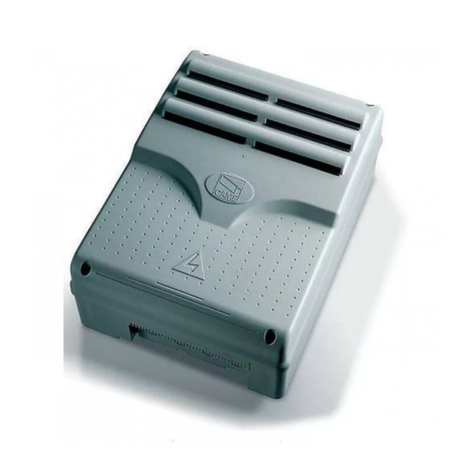
CAME
CAME zl92 installation manual
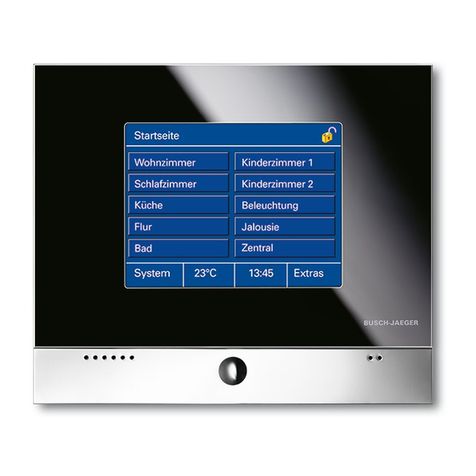
Busch-Jaeger
Busch-Jaeger 6136/30M operating instructions
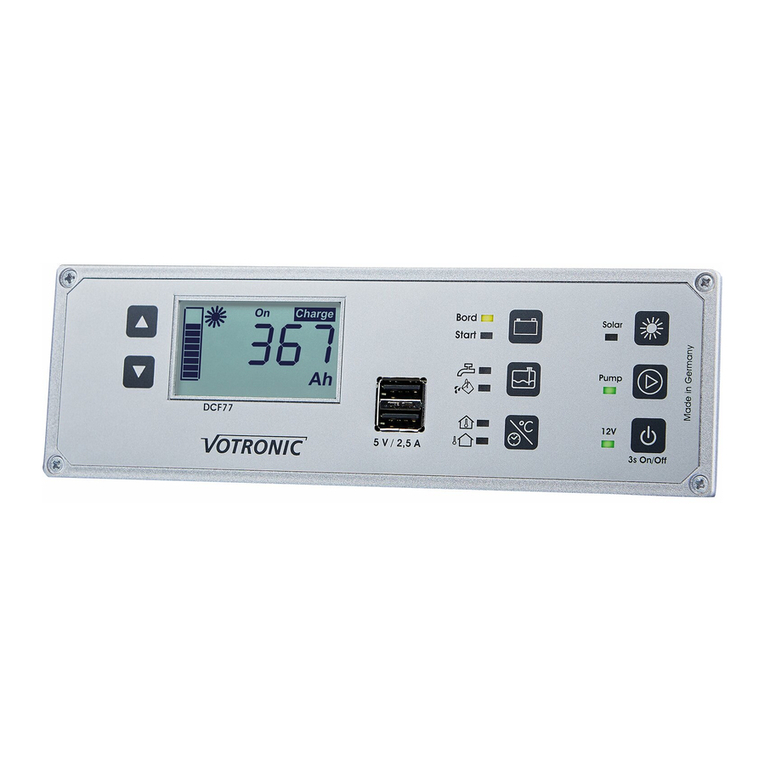
Votronic
Votronic VPC Jupiter 100 Installation and operating manual

alre
alre b@home FTRCUd-210.021 operating instructions
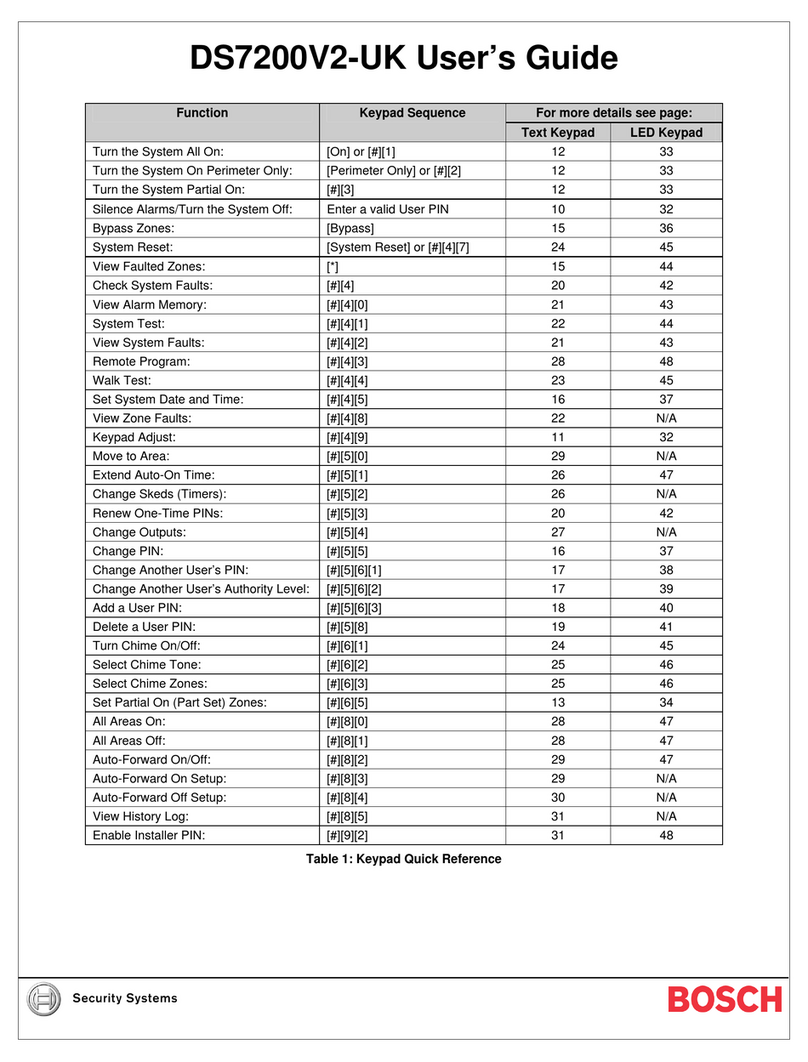
Bosch Security
Bosch Security DS7200V2-UK user guide
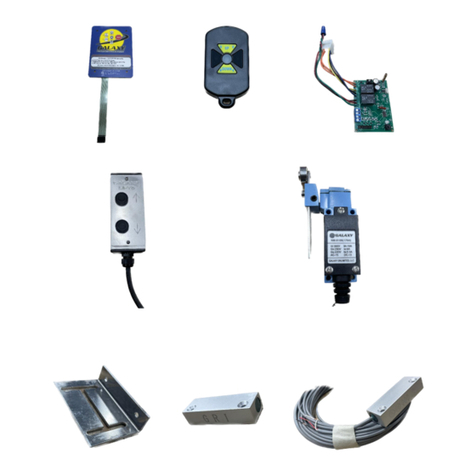
Galaxy
Galaxy 1M2S Wiring and Programming Guide
